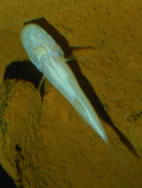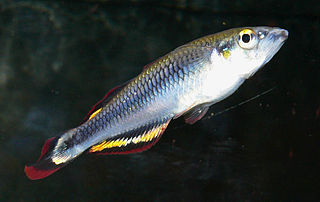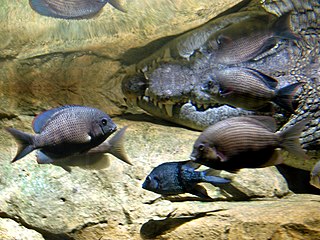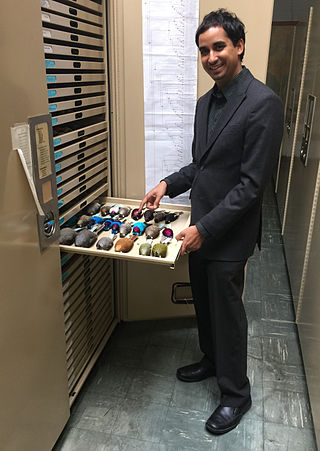
The Amblyopsidae are a fish family commonly referred to as cavefish, blindfish, or swampfish. They are small freshwater fish found in the dark environments of caves, springs and swamps in the eastern half of the United States. Like other troglobites, most amblyopsids exhibit adaptations to these dark environments, including the lack of functional eyes and the absence of pigmentation. More than 200 species of cavefishes are known, but only six of these are in the family Amblyopsidae. One of these, Forbesichthys agassizii, spends time both underground and aboveground. A seventh species in this family, Chologaster cornuta, is not a cave-dweller but lives in aboveground swamps.

The Alabama cavefish is a critically endangered species of amblyopsid cavefish found only in underground pools in Key Cave, located in northwestern Alabama, United States in the Key Cave National Wildlife Refuge. It was discovered underneath a colony of gray bats in 1967 by researchers Robert A. Kuehne and John E. Cooper and scientifically described in 1974.

Bedotia is a genus of the family Bedotiidae of fishes endemic to Madagascar.
Glossogobius ankaranensis is a species of fish in the family Gobiidae. This cavefish is endemic to the Ankarana Reserve in Madagascar. Its natural habitat is inland karsts.
Milyeringa is a genus of blind cavefish from the Cape Range and Barrow Island, northwestern Australia. Although traditionally considered to belong to the family Eleotridae, studies show that they represent a distinct and far-separated lineage together with the Typhleotris cavefish from Madagascar, leading some to move them to their own family, Milyeringidae. The generic name is taken from Milyering which is 20 miles (32 km) southwest of Vlamingh Head in the North West Cape of Western Australia, the type locality for Milyeringa veritas.

The Mexican blind brotula is a species of viviparous brotula endemic to Mexico, where it is found in sinkholes and caves. It is known as sak kay in Mayan and dama blanca ciega in Spanish. This cavefish grows to a standard length of 9.7 cm (3.8 in). It is the only known member of its genus.
Paretroplus nourissati, the lamena, is a species of cichlid from the vicinity of the confluence of the Amboaboa and Mangarahara Rivers near Mandritsara in northern Madagascar. This relatively elongate Paretroplus reaches about 16 centimetres (6.3 in) in length, and is closely related to P. lamenabe and P.tsimoly. P. nourissati is threatened by habitat loss and invasive species.

Ptychochromis oligacanthus is a species of cichlid endemic in fresh water habitats in the western part of the Antsiranana Province in Madagascar. The population on the island of Nosy Be appears to be stable, but the mainland populations are threatened by habitat loss. It reaches a length of 25 centimetres (9.8 in) TL.
Ptychochromis loisellei is a species of cichlid from the Mahanara River basin north of Sambava in northeastern Madagascar. It remains common within its small range, but it is threatened by habitat loss and introduced species. It reaches about 11.9 centimetres (4.7 in). The similar named Paretroplus loisellei is also restricted to the Mahanara River basin. The specific name honours Paul V. Loiselle, Emeritus Curator of Freshwater Fishes at the New York Aquarium and a researcher in, and campaigner for the conservation of, the freshwater fish of Madagascar.
Ptychochromis curvidens is an endangered species of fish in the cichlid family. It is endemic to a few rivers that flow west from Montagne d'Ambre in far northern Madagascar. It is threatened by habitat loss and introduced species. It reaches about 14.7 cm (5.8 in) in standard length.

Ptychochromoides is a genus of cichlids endemic to Madagascar. Of the three described species, two are critically endangered and one was considered extinct until rediscovered in late 2010.

Typhleotris madagascariensis is a species of fish in the family Milyeringidae that is endemic to Madagascar, where it is only known from underground waters in the southwestern portion of the island. This cavefish is blind and lacks pigmentation, and can reach a standard length of 8 cm (3.1 in).

Typhleotris is a genus of cavefish that are endemic to caves in southwestern Madagascar. Although traditionally considered to belong to the family Eleotridae, studies show that they represent a distinct and far-separated lineage together with the Milyeringa cavefish from Australia, leading some to move them to their own family, Milyeringidae.
Typhleotris pauliani is a critically endangered species of fish in the family Milyeringidae that is endemic to Madagascar, where it is only known from a few caves and sinkholes in the southwestern portion of the island. This blind cavefish lacks pigmentation and can reach a standard length of 7.1 cm (2.8 in). It feeds on invertebrates and guano. Part of its range receive some protection, but the species is threatened by disturbance from recreational activities and collectors of guano. The specific name honours the French entomologist and former deputy director of the Institut de recherche pour le développement in Madagascar, Renaud Paulian (1913-2003), who collected the type specimens as well as contributing a lot to the knowledge of the biogeography of the western Indian Ocean.

Cavefish or cave fish is a generic term for fresh and brackish water fish adapted to life in caves and other underground habitats. Related terms are subterranean fish, troglomorphic fish, troglobitic fish, stygobitic fish, phreatic fish and hypogean fish.
Caecieleotris morrisi, also known as the Oaxaca cave sleeper is a species of troglobitic fish in the family Eleotridae found in a single cave system beneath Presa Miguel Alemán reservoir, northern State of Oaxaca in Mexico. This species is the only member of its genus.

Milyeringidae, the blind cave gobies, is a small family of gobies, in the order Gobiiformes. There are two genera and six species within the family, which is considered to be a subfamily of the Eleotridae by some authorities. Milyeringidae includes one genus (Milyeringa) restricted to caves in the North West Cape region of Australia and the other (Typhleotris) to underground water systems in Madagascar. They are all troglobitic species and have lost their eyes.

Prosanta Chakrabarty is an American ichthyologist and professor of ichthyology, evolution and systematics at Louisiana State University. He studied at McGill University where he received a bachelor of science in Applied Zoology and at the University of Michigan where he obtained his PhD in Ecology and Evolution. Among other professional positions he was a Program Director for the National Science Foundation and is currently the President-Elect of the American Society of Ichthyologist and Herpetologist. He was named a TED Fellow in 2016, and a TED Senior Fellow in 2018. He was named an Elected Fellow of the AAAS for "distinguished contributions to evolutionary biology, focusing on the bioluminescent systems and historical biogeography of freshwater fishes, and for effectively communicating science to the public."
Ptychochromis mainty is a species of cichlid from the subfamily Ptychochrominae, a subfamily which is endemic to the freshwaters of Madagascar. It has only been recorded from forested streams in the vicinity of Fort Dauphin in the south eastern part of the island. Its closest relative is Ptychochromis grandidieri.
Anjanamba is the name of a cave in South-Western Madagascar, Atsimo-Andrefana region, in the Mikea Forest. It is a fully submerged cave system that has been explored to more than 10km using cave diving techniques. It is the longest underwater cave of Africa.









